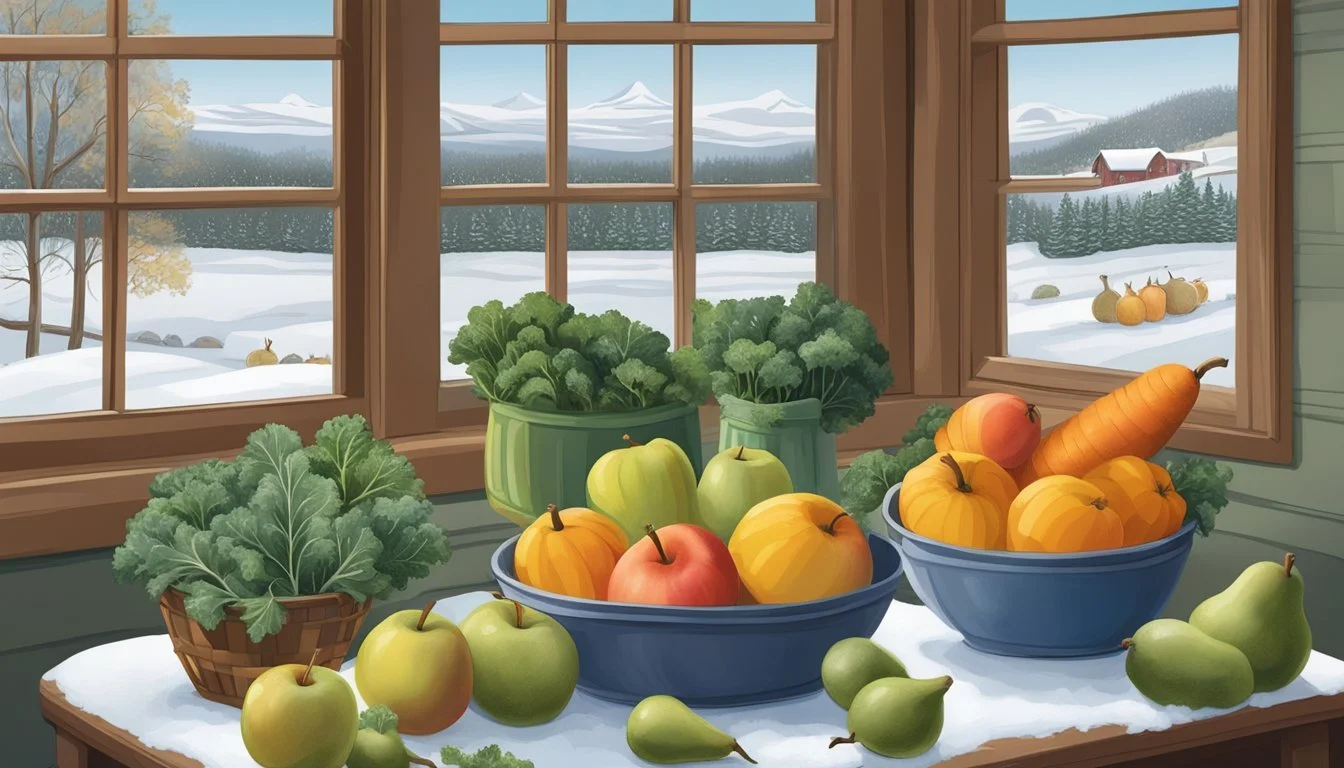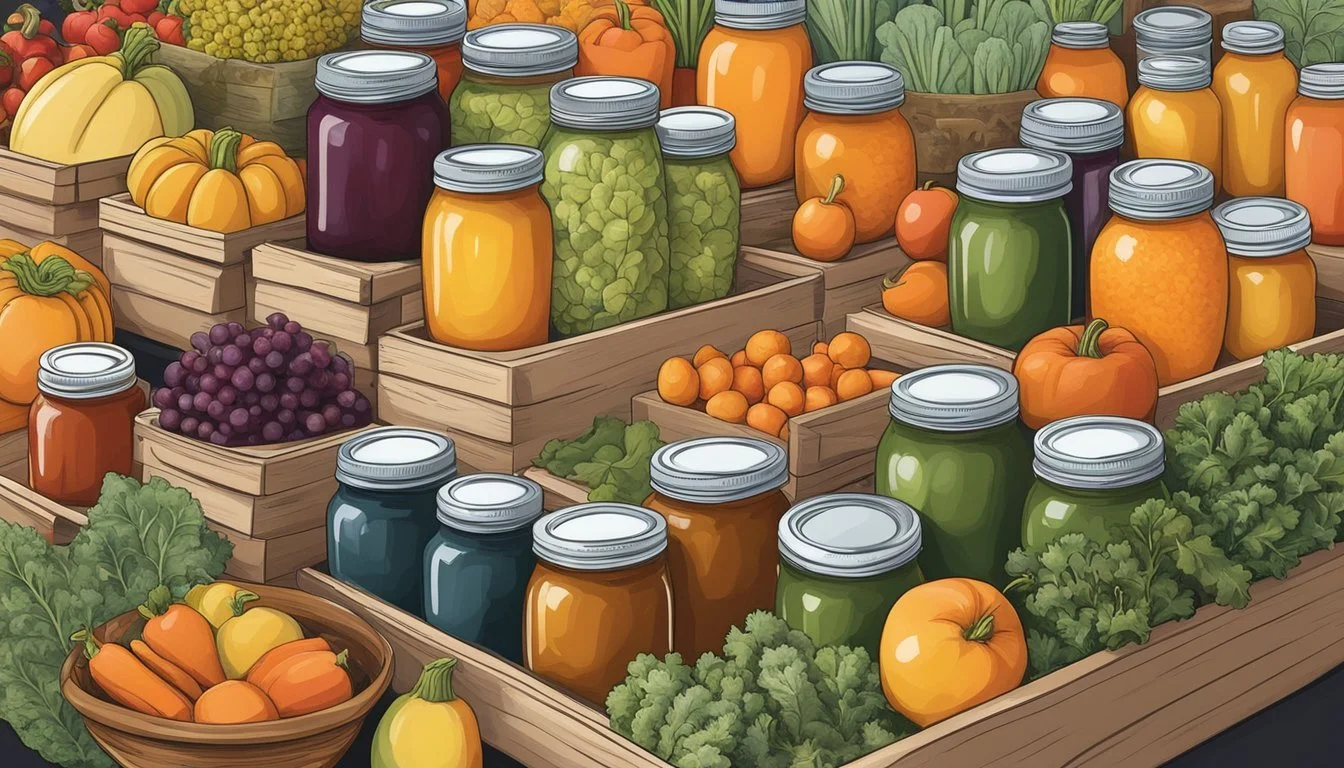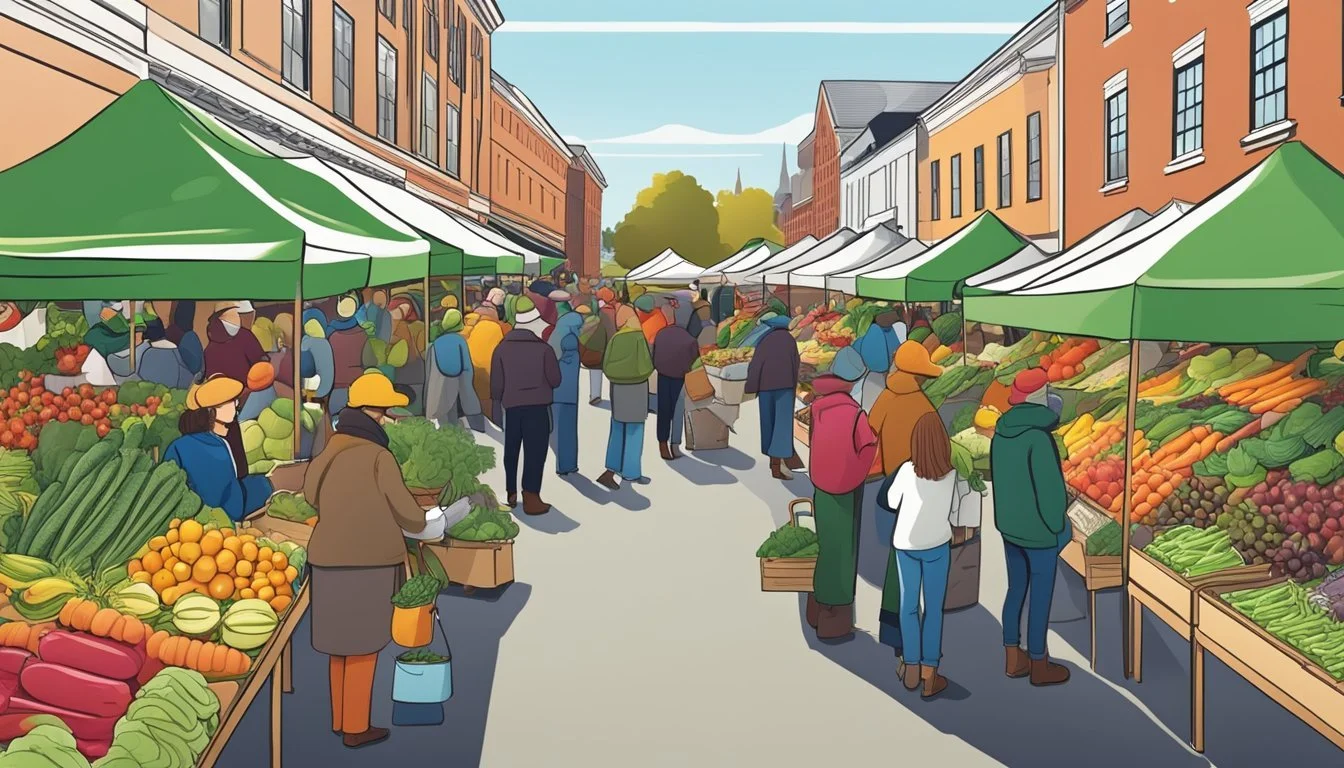Virginia Seasonal Fruit & Vegetables in January
A Guide to Fresh Produce
This Article is Part of our Virginia Seasonal Fruit & Veg Calendar
Seasonal eating in Virginia during January puts a spotlight on the state's winter harvest. Virginia is known for cultivating an array of fruits and vegetables that can withstand the cooler temperatures of winter, ensuring fresh produce is available even during the colder months. Selecting fruits and vegetables that are in season not only supports local farmers but also provides consumers with the freshest, most nutritious options.
In January, the selection of produce includes a variety of root vegetables and hardy greens that are tolerant to Virginia's winter climate. Turnips, which thrive from September through March, are among the produce that can be harvested during this time. They offer a versatile ingredient for winter recipes, from roasted dishes (What wine goes well with roasted dishes?) to soups (What wine goes well with soups?). Meanwhile, apples, which have a long harvest season extending through November, are typically still available in January, providing a crisp and juicy snacking option. These seasonal choices reflect the resilience of Virginia's agriculture and the adaptability of its produce offerings.
Overview of Virginia's Seasonal Produce
January in Virginia is a showcase for the resilience of in-season produce, highlighting a variety of fruits and vegetables that thrive despite the cooler weather. Root vegetables and winter squash take center stage at local markets, demonstrating the season's ability to yield flavorful and nutritious offerings.
January Climate and Its Influence on Crops
Virginia's January climate can be characterized by its typically cold temperatures, which can significantly affect the growth cycles of many crops. Despite these chillier conditions, certain fruits and vegetables remain hardy and available. Poised to withstand the frost, root vegetables such as sweet potatoes and a range of winter squash are in abundance due to their ability to be stored well after harvest, ensuring a steady supply throughout the season.
The Role of Local Farms in Seasonal Produce
Local farms are instrumental in providing the seasonal fruits and vegetables that are available in Virginia during January. These farms adeptly navigate the challenges presented by the winter climate through practices such as crop rotation and choosing frost-resistant varietals. As a result, consumers may find local markets well-stocked with seasonal produce like sweet potatoes, various herbs, and some sturdy leafy greens. By sustaining close relationships with these farms, Virginia's markets can reliably offer fresh, in-season produce to their customers.
Seasonal Fruits in January
January offers limited fresh produce options in Virginia, but it is a peak time for certain types of fruit. Citrus fruits, as well as apples and pears, remain plentiful, providing both taste and nutrition during the colder months.
Citrus Fruits Availability
During January, citrus fruits are at their most vibrant and are widely available in Virginia. Varieties such as oranges, lemons, and grapefruits are not only ripe but also known for their immune-boosting properties. Their high vitamin C content is particularly beneficial during the winter season.
Oranges: Juicy and rich in flavor, perfect for eating fresh or juicing.
Lemons: Essential for their zest and juice, often used to enhance flavors in dishes.
Grapefruits: Known for their slightly tart taste and refreshing quality.
Apples and Pears Varieties
Apples and pears continue to be accessible from fall harvests and are commonly consumed throughout January. These fruits offer versatility in culinary uses and are a source of fiber and essential vitamins.
Apples: Various types ranging from sweet to tart, ideal for both raw consumption and cooking.
Pears: Ripe pears are tender and sweet, suitable for elegant desserts or as a nutritious snack.
Consumers will find that apples and pears maintain their firmness and flavor profile well into the winter, making them dependable choices for seasonal recipes.
Seasonal Vegetables in January
January in Virginia showcases a robust selection of cool-weather vegetables. During this month, grocery lists are often filled with hearty root vegetables and nutrient-rich brassicas that can withstand the chilly temperatures.
Root Vegetables and Brassicas
Root Vegetables:
Turnips: These versatile vegetables can be roasted, mashed, or added to stews.
Beets (how long do beets last?): High in fiber and Vitamin C, beets are perfect for salads and side dishes.
Carrots: A staple in many kitchens, carrots can be enjoyed raw, steamed, or as part of a mirepoix.
Parsnips: With a sweet, earthy flavor, parsnips are a warming addition to any meal.
Potatoes: A classic choice, potatoes are available in many varieties and are extremely versatile.
Rutabagas: Also known as swede, rutabagas are similar to turnips with a slightly sweeter taste.
Brassicas:
Cabbage: Ideal for slaws or fermented dishes like sauerkraut (how long does sauerkraut last?).
Broccoli (how long does broccoli last?): A vitamin-rich vegetable, excellent steamed or roasted.
Cauliflower: Its mild flavor makes it a great canvas for spices and sauces.
Brussels Sprouts (how long do brussels sprouts last?): When roasted, they offer a deliciously crisp and caramelized edge.
Kale: Known for its health benefits, kale can be used in salads or as a cooked green.
Leafy Greens and Other Vegetables
Greens:
Collard Greens (how long do collard greens last?): A southern cooking staple, they are often simmered with flavorsome stock.
Spinach: This tender leaf can be eaten raw or just wilted, packed with iron and vitamins.
Lettuce: Various types are available, providing the base for winter salads.
Other Vegetables:
Leeks: This milder cousin of the onion adds depth to soups and stews.
Garlic: A foundational element that brings warmth and aroma to winter dishes.
Onions: Their pungency and versatility make them indispensable in the kitchen.
Celery and Celery Root: Celery root or celeriac adds a nutty flavor to soups, while celery is often used for its crunch and freshness.
Vegetables harvested during the cold months often have a denser nutritional profile. They can be a great source of Vitamin C and other essential nutrients, providing a natural boost to the immune system during the winter season. Additionally, proper storage of these seasonal vegetables can extend their shelf life, ensuring a continuous supply of fresh produce throughout the colder months.
Seasonal Recipes
January in Virginia is an ideal time to explore the richness of seasonal produce through an array of recipes that cater to both the need for warmth and the desire for nutrition.
Comforting Warm Dishes
One can harness the distinctive taste and comforting qualities of winter vegetables in warm dishes. A root vegetable stew makes a hearty and flavorful meal, with locally available turnips, carrots, and perhaps a hint of sage for an enhanced herbal note. This stew can be served over a bed of rice (how long does rice last?), ensuring a filling dish that is both comforting and satisfying during the colder days.
A cabbage and kale-infused soup also serves as an excellent option, perhaps with a sprinkling of herbs like thyme which is available year-round in Virginia. The soup's vibrant flavors and nutritious profile make it not only a comforting meal but also a testament to the local produce.
Healthy and Nutritional Options
For those seeking lighter fare that doesn't compromise on nutrition, a variety of salads and vegetable-forward recipes are available. Incorporating roasted beets into a salad with a citrus dressing not only adds a splash of color but provides a nutritious boost. The earthiness of beets contrasts nicely with the tangy taste of seasonal citrus, such as lemons.
A Brussels sprouts and broccoli rice bowl is another healthy recipe one can consider. The green vegetables, rich in vitamins, can be lightly sautéed with garlic and served over rice, offering a complete meal that is both high in nutrition and flavor. Pairing such dishes with herbs like rosemary and thyme can elevate the food's overall profile, contributing not only to its taste but also to its potential health benefits.
Health Benefits and Nutrition
Eating seasonally in January in Virginia not only supports the local economy but also provides nutritional benefits. The available produce is rich in essential vitamins and minerals that are crucial for maintaining health during the colder months.
Vitamins and Minerals Contribution
Citrus Fruits: They are an excellent source of Vitamin C, which is vital for immune system function and skin health. Citrus fruits like oranges are widely available and offer a fresh taste amid the hearty winter fare.
Leafy Greens: Vegetables such as kale and Swiss chard contribute high levels of Vitamins A, C, and K. They also provide minerals such as calcium and iron. These nutrients are essential for vision, blood clotting, and bone health.
Root Vegetables: Turnips and carrots found in Virginia during January are dense with nutrients. These vegetables are packed with fiber, which aids in digestion, and antioxidants, which combat oxidative stress in the body.
Dietary Advantages of Seasonal Produce
Flavor: Seasonal fruits and vegetables often present a superior taste as they are harvested at their peak of freshness.
Nutrition: Produce in season may contain higher nutritional value than off-season counterparts. For example, consuming food that is in season is like getting a timely dose of the specific nutrients the body needs during that time of year.
Variety: Seasonal eating naturally rotates the foods in one's diet. This variety can introduce the body to a broader spectrum of nutrients and reduce the risk of developing food intolerances.
Food Preservation and Storage
Effective food preservation extends the shelf-life of January's harvest while maintaining nutritional value. Proper storage solutions and preservation techniques are crucial for enjoying seasonal produce beyond their natural cycle.
Short Term Storage Solutions
Refrigeration is the primary method for short-term storage of many fresh fruits and vegetables. Firm-skinned fruits like apples should be kept in a crisper drawer away from vegetables to reduce ethylene gas exposure. Vegetables such as beets and broccoli benefit from being stored in perforated plastic bags to retain moisture but avoid spoilage due to condensation.
Celeriac/celery root should be wrapped in plastic and placed in the refrigerator, ensuring any green tops are removed to prevent siphoning moisture from the root.
Produce Storage Method Apples Crisper drawer, separate from vegetables Beets Perforated plastic bags, refrigerate Broccoli Perforated plastic bags, refrigerate Celeriac/Celery Root Wrap in plastic, refrigerate without tops
Long Term Preservation Techniques
For long-term conservation, canning, freezing, and drying are reliable techniques. Apples can be turned into sauces or jams and canned, providing a shelf life of over a year when done correctly. Beets can be pickled, a form of canning, which not only preserves but also adds flavor. Broccoli is best blanched before freezing to preserve its texture and flavor.
Vegetables like collard greens can be blanched and frozen, extending their usability for several months. Lastly, herbs such as cilantro, which are available year-round, can be dried and stored in airtight containers.
Produce Preservation Technique Apples Canning as sauce or jam Beets Pickling Broccoli Blanching and freezing Collard Greens Blanching and freezing Cilantro (Herbs) Drying and storing in airtight containers
Seasonal Eating and Local Markets
January in Virginia showcases the charm of seasonal eating, where the cold weather brings a specific bounty to the local markets. Patrons shopping during this month can discover a variety of winter-harvested produce and locally-sourced items to enrich their diets and support the local economy.
Finding Produce in Virginia's Markets
Local markets in Virginia thrive on the commitment to seasonal offerings. During January, visitors to these markets are likely to find root vegetables and winter greens that withstand the chill of Virginia's winters. Apples and turnips are staple crops, often available due to their ability to be stored well after harvest. Consumers may also encounter winter squash, which is typically available through January. A reliance on these seasonal foods is not only beneficial for local farming sustainability but also offers a freshness that can be lacking in non-seasonal imports.
Local Market Examples in January:
Apples: A variety of apples are typically available, ideal for both eating raw and cooking.
Turnips: Often found during this time, offering a robust flavor to winter dishes.
Winter Squash: Adds a hearty element to meals, with varieties such as butternut or acorn squash.
Seasonal Food Trends on Social Networks
Social networks like Pinterest and Facebook serve as a barometer for what's trending in seasonal foods. They reflect the collective enthusiasm for recipes and market finds that celebrate the season's offerings. Users frequently share their local market experiences and the dishes they create from their hauls, contributing to a broader community engaged in seasonal eating. Photographs of farmers’ market adventures and the resulting culinary creations often gain traction, inspiring others to explore the richness of Virginia's seasonal produce.
Social Network Trends:
Pinterest: Boards and pins committed to winter recipes, particularly those with seasonal vegetables like butternut squash (how long does butternut squash last?) or kale.
Facebook: Local groups and pages where community members boast about their market finds and share seasonal recipes.
Gardening and Growing Tips
January presents unique opportunities for both indoor cultivation and outdoor gardening in Virginia, with certain vegetables capable of thriving in the colder weather.
Indoor Cultivation
In Virginia, indoor cultivation allows gardeners to extend their growing season. Starting seeds indoors can give a head start to crops that will be transplanted outside once the weather warms. Lettuce, kale, and spinach are excellent choices for indoor sowing in January due to their cold tolerance. Gardeners should ensure their indoor set up has sufficient light—either from a south-facing window or grow lights—and maintain a steady temperature ideally between 65°F and 75°F.
Outdoor Gardening in Virginia
Outdoor gardening in January in Virginia poses challenges due to low temperatures and potential frost. However, certain hardy vegetables can be sown directly into the ground or in cold frames and greenhouses. Root crops such as carrots and radishes, as well as leafy greens like collards and mustard greens, are some options that can withstand the cold. Farmers should protect these crops with mulch or row covers and be mindful of the soil moisture as winter precipitation can be variable. Proper drainage is essential to prevent root rot during wetter periods.
Economic Aspects of Seasonal Produce
Purchasing seasonal produce in Virginia during January has specific economic implications both for consumers and local producers. The costs associated with seasonal food and the broader impact on local communities are substantial factors in understanding this dynamic.
Costs of Seasonal Food
Consumers usually find lower prices on fruits and vegetables that are in season. With January marking the availability of items like kale, sweet potatoes, and various winter squashes, transportation and storage costs are reduced. These savings often trickle down to the consumer. In contrast, out-of-season produce requires extended cold storage or long-distance shipping, leading to higher retail prices.
For example:
Kale – Locally grown kale is generally less expensive during its peak season.
Apples – Stored from fall harvest, they may be modestly priced due to efficient storage techniques.
Economic Impact on Local Communities
Seasonal produce contributes significantly to local economies. When consumers buy seasonally, they are more likely to purchase from local farmers and markets, injecting capital directly into their community. This supports not only the farmers but also related businesses such as local seed suppliers, equipment dealers, and food processors.
The economic boost includes:
Job Creation – Increased need for labor at local farms and markets.
Sustainability – Reduced transportation distances save fuel and lower greenhouse emissions, supporting environmental sustainability goals.
Purchasing Virginia's seasonal produce in January not only offers economic benefits to consumers through lower costs but also bolsters local economies by sustaining agriculture and associated industries.










